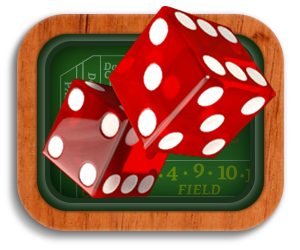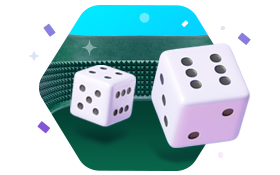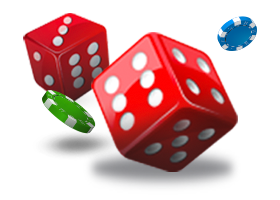
Craps is renowned for its thrilling dynamics and intricate gameplay, posing a unique challenge. Mastering the art of craps betting is essential for new dealers aiming to gain expertise in the game.
In this guide, we’ll dive into the different types of craps bets and their payouts, giving you helpful tips and advice. Whether you’re just starting or want to improve your skills, discover the secrets to becoming a successful craps dealer.
Getting Started as a Craps Dealer


Craps is the hardest game for a dealer to learn, emphasizing the importance of understanding craps betting for effective strategy execution. New dealers typically invest two years of full-time work, five days a week, eight hours a day, to attain adequate proficiency.
To secure a position as a craps dealer, it’s best to prioritize learning blackjack first, followed by on-the-job training. This approach allows for skill acquisition during paid work hours, avoiding the expense of formal education.
Utilize breaks to familiarize yourself with other games, starting with mini-baccarat, then pai-gow poker, roulette, and finally, craps. Job security is essential, especially considering the steep learning curve associated with craps.
Because of the initial challenges they encounter, many new dealers decide to put off learning how to play craps. However, practicing at home is key for mastering the game and playing like a pro.
Engaging in craps drills is invaluable for new dealers, helping them refine their betting techniques, including booking bets, managing across and prop bet keys, and more.
Quick Glossary for Craps Betting System
- Buy and Lay Bets: Placing a bet on a specific number to be rolled before a 7 (Buy) or after a 7 (Lay), with adjusted payouts.
- Come Bet: Similar to the Pass Line bet but made after the point is established.
- Come Out Roll: The initial roll in a round of craps to establish the point.
- Don’t Pass Bets: Opposite of Pass Line bets, where players win on a come-out roll of 2 or 3, lose on 7 or 11 and establish a point on 4, 5, 6, 8, 9, or 10.
- House Edge: The casino’s advantage over players in a particular bet, represented as a percentage of the wage.
- Main Bet: The primary wager placed by a player during a game of craps.
- Odds Bet: An additional bet made in support of a Pass Line or Come bet after the point is established, with payouts based on true odds.
- Pass Line Bet: A fundamental bet where the player wins if the come-out roll is 7 or 11 and loses if it’s 2, 3, or 12. Any other number establishes a “point” for subsequent rolls.
- Place Bet: Betting on a specific number (4, 5, 6, 8, 9, or 10) to be rolled before a 7.
- Point: The number established by the come-out roll in a game of craps, which players must roll again before rolling a 7 to win.
- Self-Service Bet: Bets that players place themselves without assistance from the dealer, typically involving the layout of the craps table.
- Seven Out: Rolling a 7 after the point is established, causing the loss of Pass-Line bets.
- Side Bet: Additional wagers made alongside the main bet, often on specific outcomes or events within the game.
- The Field: A one-roll bet on 2, 3, 4, 9, 10, 11, or 12 in the next roll.
- True Odds: The real probability of an event happening without the casino’s advantage factored in.
Understanding Craps Bets and Their Payouts


Craps can seem like a complicated game, especially when considering the various craps betting options. However, it can be seen as another straightforward casino game if broken down into its core elements.
A typical casino game has a main bet and a side bet. It’s the same with craps. The main bet is your Pass Line Bet, where the player bets that a certain number will roll twice before a 7.
Two variations of this main Pass Line Bet include the Come Bet and the Place Bet. The player bets a certain number will hit before a 7 on each of these variations.
The rest of the bets can be considered side bets that the player will play while waiting for their main bets to hit.
The remaining bets, often considered side bets, provide additional opportunities for players to win while waiting for their main bets to hit.
Down below, we’ll explain the basic bets like the Pass Line to more intricate options such as Buy and Lay Bets, all essential for playing real money craps.
Explore each bet’s odds, payouts, and strategic usage to enhance your understanding of the game.
Pass Line Bet & Odds
A new round begins on the “Come Out“ roll when the puck is marked as “Off.” The casino requires a mandatory bet on the Pass Line, or Don’t Pass Line, for the Shooter to roll the dice.
The Stickman will offer the Shooter five dice to choose from, and the Shooter will pick up two.
If the Shooter rolls a 7 or an 11, all the players will win Even Money on their Pass Line Bet.
If the dice rolls a 2, 3, or 12, then this is known as “Craps” or “Crapping Out” and the Pass Line Bet will lose. The House Edge for the Pass Line is 1.41%.
On the Don’t Pass bets, the opposite will occur. However, Bar 12 means your bet will push if a 12 is rolled. Considering that Bar 12 is a tie, the House Edge for the Don’t Pass Line is 1.36%.
After establishing the Point, players can take Odds by placing an additional wager behind their Pass Line Bet.
The odds will be paid differently depending on what number the Point is. If the Point is a 4 or 10, the odds will be paid 2 to 1. If the Point is a 5 or 9, the odds will be paid 3 to 2; if the Point is a 6 or 8, then the odds will be paid 6 to 5.
The odds are paid as True Odds, meaning there is no house advantage. Laying odds on the Don’t Pass Line is the same as taking odds on the Pass Line, except reversed.
For example, if the Point is a 5 and the player laid odds on the Don’t Pass Line and a 7 hits, then instead of being paid 3:2, like he would if he was playing odds on the Pass Line, it would be reversed and the player would be paid 2:3.
Meaning, his three red chips, $15, would be paid with two red chips, $10.
Establishing a Point
If the Shooter rolls a 4, 5, 6, 8, 9, or 10, a Point is established, and the marker will be turned to the “On” position and placed on the appropriate number.
The Shooter’s goal is to roll the number again before rolling a 7, also known as Seven Out.
If the Shooter rolls a 7, then the Pass Line loses, and the dice will be passed clockwise to the new Shooter. However, if the Shooter rolls the Point, the Pass Line wins.
The Shooter will keep the dice, and a new round will begin.
The only numbers that matter once a Point has been established are the Point itself and the number 7.
The rest of the numbers will remain unaffected unless the player bets on a side bet, such as the Field or one of the Proposition bets.
Come Bet
Playing the Come Bet is similar to playing another Pass Line Bet, except on the numbers that aren’t designated as the Point.
Each player can only make one Come Bet at a time, and players may only bet after a Point has been established.
- If a 7 or 11 are rolled, then the Come Bet wins.
- If a 2, 3, or 12 are rolled, it loses.
- If any other number is rolled, the bet will be moved to that numbered box in front of the dealer, and the player can now take odds.
Remember that the Come Bets are always “Working” (or active) and are never turned off. However, the odds associated with that Come Bet will be turned off when the puck indicates so.
The winning Come Bets are paid the same way as the Pass Line Bets: Even Money for the Original Flat Bet and True Odds for the Odds Bet.
Think of the Don’t Come Bet as being the same as the Come Bet, except the Don’t Come Bet can be made at any time except during a Come Out roll.
- If a Point is established and a 7 is rolled, the Don’t Come bets win
- If the Point is rolled, the Don’t Come Bets lose
- and if a 12 is rolled, they push.
Place Bet
Place Bets are similar to Come Bets, except you don’t need to make a Come Bet or a Pass Line Bet first. However, they pay fewer odds.
Place Bets can be made anytime except during the Come Out Roll. The player will notify the dealer when they want to make a Place Bet, and then they’ll pass their wager to the craps dealer for placement.
The player bets that their selected number will be rolled before a 7. If the player wins, the base wager will be paid Even Money, and the odds will be paid according to the winning number.
- If a 4 or 10 wins, the odds will be paid 9 to 5, giving us a house edge of 6.67%.
- If a 5 or 9 win, then the odds will be paid 7 to 5, giving us a house edge of 4%
- If a 6 or 8 win, then the odds will be paid 7 to 6, giving us a house edge of 1.52%.
If the player wants to receive the correct payout for a 4, 5, 9, or 10 place bet, their odds should be made in increments of $5. If the player wants to make a correct payout for a 6 or 8, their odds bet should be in increments of $6.
Buy Bets & Lay Bets
Buy Bets are the same as Place Bets. Only the player gets paid true odds.
Players can buy any number by stating, “I’d like to buy the 5”; however, they must pay a 5% commission, or vig, on the bet.
Because of the vig, the house edge is higher for players who buy the 5, 6, 8, or 9 versus placing those bets. Yet the house edge for the 4 and 10 are lower, so players habitually buy the 4 and 10 but no other number.
Lay Bets are the same as Buy Bets, except they’re designated for the Don’ts. Players still have to pay a vig, but just like laying the odds, if the player has a $20 lay bet on the 4, they’ll win $10.
Field Bet
The Field Bet can be placed at any time, and this is a Self-Service bet, meaning that the Players are responsible for adding or taking away the cheques.
This is a one-roll bet that wins if the dice roll a 2, 3, 4, 9, 10, 11, or 12.
It pays even money unless a 2 or a 12 is rolled, and then it pays 3 to 1 or 2 to 1, depending on what casino you’re in.
- If the twelve pays 3 to 1, the House Edge for the Field is 2.78%.
- If the twelve pays 2 to 1, the House Edge goes up to 5.56%.
Types of Proposition Bets
Proposition bets are side bets that are located in the middle of the craps table. You can tell what one-roll bets or multiple-roll bets are by the color of the text.
Remember that every casino is different when considering Proposition odds, so some might pay different odds than others.


Game Security When Dealing Craps
In this section, we focus on keeping craps games fair and secure. Explore how to ensure honest play, detect cheating attempts, and uphold the integrity of the game.


- One of the key components of game security is when the casino staff follows all of the procedures at all times. By doing so, this maintains the honesty & integrity of the craps games.
If there’s any break in procedure, no matter how small, this can signal cheating by either the dealer or the player.


- The dealer and the Floorman should always be paying attention to the game and what is happening around them. They should be alert to any unusual hand movements or patterns that the player might display, and they should pay attention to the player’s conversations.


- The equipment, maintenance, and upkeep are vital for game security.
Some casinos never remove the old padding on their tables and instead put the replacement padding on over it. This creates a softer table than it needs to be.
A harder craps table creates a more random bounce since the dice tend to catch on a corner and tumble more. Removing all of the extra padding that will soften the table may be beneficial.


- When throwing the dice, the casino wants the player to hit the back wall every time. However, the casino is looking at the intent of the player. The player must intend to hit the back wall on every roll.
Players who casually pick up the dice and throw them will be given more leeway than players who set the dice in a certain position and lightly toss them.
When hitting these pyramid shapes on the side of the wall, the dice will slightly turn, altering their direction, thus making the outcome completely random.
This action also deters cheating, such as dice control, whip shot, blanket roll, slide shot, or twist shot. Maintenance of the pyramids includes inspecting them and ensuring they’re in good shape.
Some casinos never replace their pyramid padding, and there are certain areas around the table where the pyramids may have worn down over the years. These rounded-off points need to be replaced.


- There are several sly maneuvers used in craps to gain an edge over the House.
One of these maneuvers is Dice Sliding or Dice Scooting. This is when the player slides one die across the felt in a way that keeps a specific number facing up.
So, one die is predetermined, and the other die will be rolled with a random outcome.
The person sliding the dice will normally stand next to the stick person since this is the shortest possible distance between the shooter and the back wall.
The Slider positions the dice in a way that allows one die to remain face up on any number of the Slider’s choosing.
Typically, that number will be 6, which will cut down the number of times a 7 is rolled. It also eliminates the numbers 1 through 6, so the cheaters will only bet on 8 and higher.
The die that the shooter scooted will always come up short of the wall, close enough that the Stickman won’t call “No Roll” but far away enough that it never hits the pyramids. At the same time, the 2nd die hits the back of the wall and tumbles around, making the outcome completely random.


- Sometimes, the Dice Slider will work with a team whose job is to distract the dealers by asking questions, talking with them, spilling a drink, betting at the wrong time, or buying in for a large amount of money.
They’ll hide this action from prying eyes by having the dice scooted underneath another player’s arm as the new player throws money or chips on the table.
The second player’s arm shields the scooter’s hand from view, allowing him to scoot the dice without anyone noticing.
When people use sly maneuvers such as these, they complete all necessary actions in the shortest amount of time feasible. These players want to get in and get out with their money as fast as possible.
Start Practicing Today to Become a Craps Expert!


Mastering the nuances of craps betting is essential for gamblers and new dealers entering the world of casino gaming. While the learning curve can be steep, prioritizing training can expedite skill acquisition.
Remember that practicing at home is the secret to winning the game and perfecting your betting strategies. Anyone can competently handle the intricacies of craps betting and succeed with commitment and practice.
Start playing craps for real money with a solid understanding of how craps bets work, and enjoy the game with confidence and expertise.



